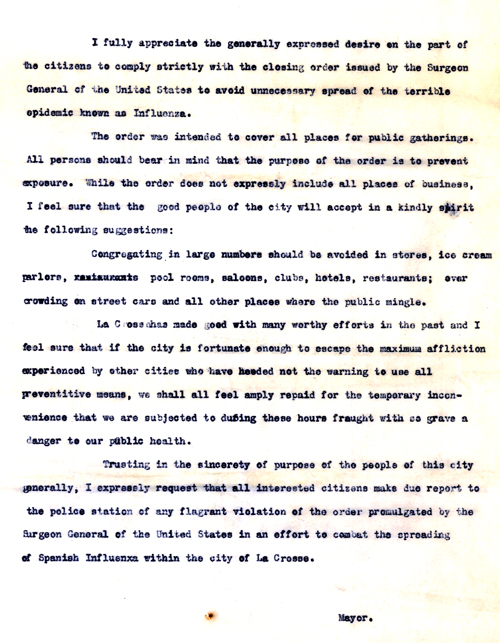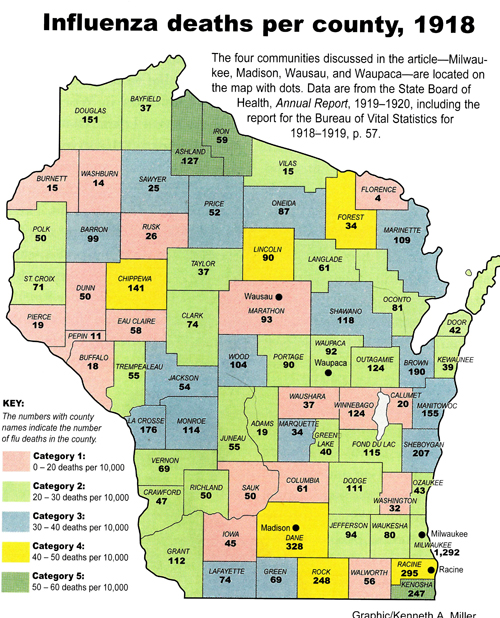
La Crosse in the 1918 Pandemic
(written by Anita Taylor Doering, Archives staff)
“No great ship sank, no armies clashed, no conflagration consumed a community. The flu spread insidiously by means of ordinary coughs and sneezes, borne through communities along the channels of human contact.” – Steven Burg, Historian.
Just over 100 years ago, World War I was de-escalating in September 1918 with the return of many United States troops headed back to American soil. Along with them came the deadly “Spanish Flu” from Europe. The last five days of September saw an increase from 6 to 97 cases in Wisconsin. That number grew to 256 new cases in one week. Not unlike the current pandemic COVID-19, the Midwest escaped the worst of the dire situation compared to densely populated areas. Reports in the newspaper and media foretold of the inevitable arrival of sickness and possible death coming from the east and the army camps which would eventually touch every coulee and valley in La Crosse County.
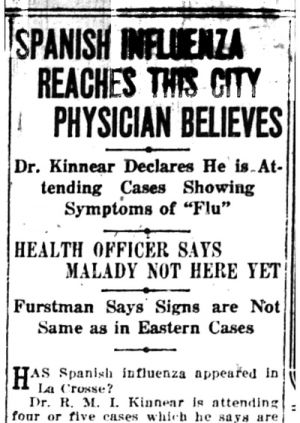
La Crosse Tribune 1 October 1918
The city of La Crosse at this time was the fifth largest city in Wisconsin, with a population of 36,000. “La Grippe” had arrived in La Crosse County by early October, maybe as early as October 1. In the beginning of the outbreak, West Salem was hit particularly hard with over one hundred cases, one death and schools were closed by October 8. Even with 40 cases reported in La Crosse, Mayor A. A. Bentley deferred closing schools based on advice from city health commissioner Dr. J. M. Furstman. The following day the newspaper began reporting deaths yet the schools remained open.
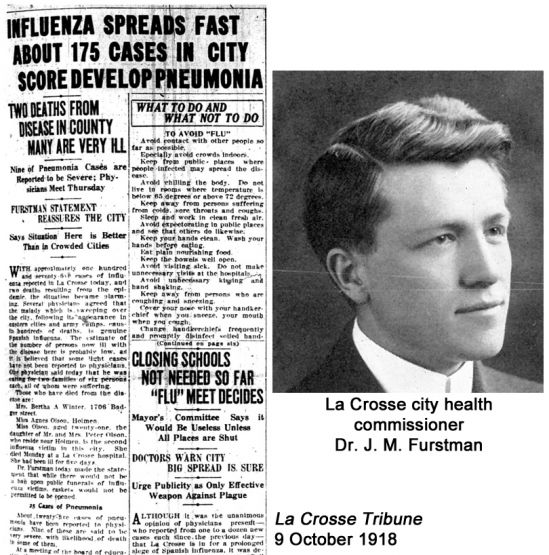
The first two fatal flu victims who contracted the disease in the county were Mrs. Bertha A. Winter, aged 30, of La Crosse, and Miss Agnes Olson, aged 21, of Holmen, and their deaths were reported in the newspaper on October 9. The city health board and Mayor Bentley expressed the need to not just close schools, but all places of business to be effective. Why the board was so sluggish to do anything, even just close schools, is a mystery.
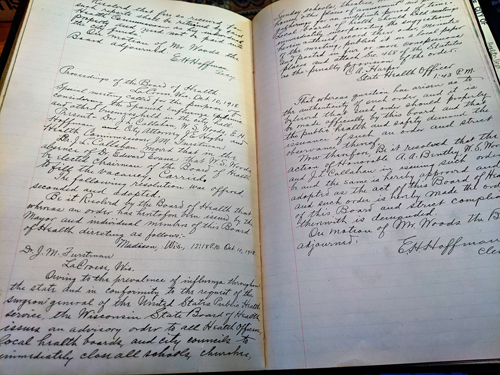
City Board of Health meeting minutes, 10 October 1918
Two days later the state of Wisconsin made the decision for La Crosse and other cities by essentially shutting down the state. In consultation with Governor Philipp, State Health Officer Cornelius A. Harper closed the state of Wisconsin. He talked to mayors and other municipal leaders in the state using “the long-distance telephone” as noted in the newspaper, explaining the need for quick action to hopefully save lives and slow the spread of the pandemic.
All schools, churches, theaters and other places where people congregated were locked up. Harper was following the advice of U. S. Surgeon General Rupert Blue but his wording in the communication was not a mandate but an “advisory order” to the local health officers, local boards of health, and city councils. La Crosse sprang into quick compliance, although not without discussion and controversy. Wausau, unfortunately, did not heed the order as quickly and suffered tremendous adversity as a result.
The Wisconsin legislature in 1876 created the State Board of Health with statewide quarantine powers. In 1883 this board required each municipal unit to appoint local health boards and health officers. This essentially created the infrastructure of a health officer in each village and city in Wisconsin. This public health network was key in work that was undertaken to educate Wisconsinites in the fight against all infectious diseases. Because the Board met quarterly, this left the sole power to essentially quarantine the state to State Health Officer Harper. The State Board of Health in hindsight realized the magnitude of its actions. “Never before in the history of the state has it become necessary to close schools, churches, theaters, saloons; in fact, everything except factories, offices and places of regular employment….”
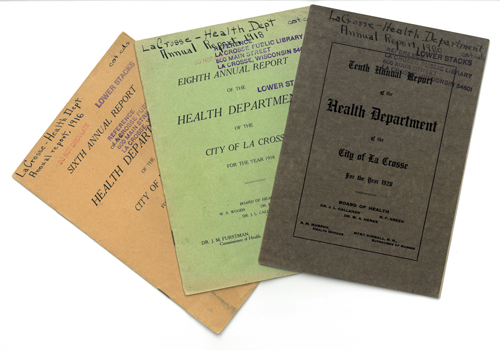
City Health Department pamphlets
When the 1918 pandemic struck, health officers and nurses were spread around Wisconsin fighting tuberculosis, smallpox, diphtheria, infantile paralysis (polio), scarlet fever and other diseases, vaccinating children when possible for smallpox and educating adults and families. They helped create laws to clean up filth in towns and cities to help reduce disease by managing waste disposal contracts, creating ordinances for city residents to connect to city water and sewer systems, inspected farms and did a lot of laboratory testing, and the like. These front-line folks were already stretched thin when the influenza struck, but Wisconsin fared better than many states because this communication network was already in place.
10 October 1918 press release from Mayor Bentley - click for full size
What made the 1918 flu so feared was that it was highly contagious and attacked not only the very young and the very old like the typical influenza strains, but this H1N1 virus strain attacked young people in their prime – otherwise healthy folks in their 20s-40s. It is thought that the virus attacked a specific enzyme in the immune system that is particularly elevated in this age group. After a short bout of typical influenza symptoms, patients would begin to resume regular activities then be hit hard with a relapse resulting in pneumonia. Of those cases, some turned fatal quickly, as these patients developed heliotrope cyanosis – a condition that filled victims’ lungs with a thick, blackish liquid and those patients generally faced death. The only known relief for the influenza was two weeks of bed rest.
The following weeks Furstman was directed by the Board to inform the local media daily about the influenza situation. Many local physicians did not believe that closing schools was a viable way to slow the spread of the disease, at least without closing all factories and places of business. Every day for most of the month of October were updates on the number of new cases.
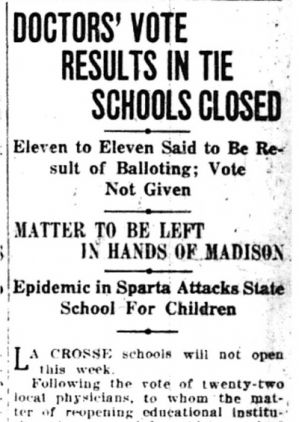
La Crosse Tribune 22 October 1918
Democracy is not without controversy and many different opinions. Already a fight was made public between Furstman and Bentley. Bentley called the Board of Health together and Furstman claimed that this action was illegal. Many doctors felt that the call to close schools would actually aggravate the situation rather than slow the spread.
Bentley pleaded with citizens to avoid crowding in all places of business that remained open and to use common sense. “Congregation in large numbers should be avoided in stores, ice cream parlors, pool rooms, saloons, clubs, hotels, restaurants; overcrowding on street cars and all other places where the public mingle.”
By October 16, the death list from pneumonia was up to eight, the age of the afflicted ranging from 19 to 31 years old. The La Crosse Chapter of the Red Cross offered nursing service, hospital supplies, organized personnel and financial credit. Many volunteer organizations like this had ramped up to help fight World War I on the home front. This spirit of patriotism also provided city and other governmental officials with cooperation by the general public to comply with the state health shut down order.
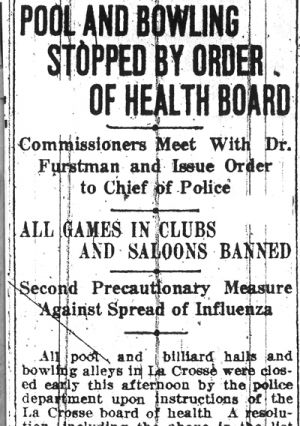
La Crosse Tribune 18 October 1918
A city Health Board meeting on October 18 authorized that a majority vote of practicing physicians would determine if schools should be reopened or not. The vote was revealed as a tie in the October 22 paper so the Board decided to leave the schools closed and wait to hear from the State Board of Health on the matter. The city Board did reiterate that all pool and billiard halls and bowling alleys be included in the general closing order – "...no games of any kind be allowed in saloons or clubs as well as ice cream parlors, candy stories and drug stories, yet the order shall not prohibit the sale of ice cream, cigars, confectionery or other articles over counters." The bottom line: spend your money but don’t linger. By this time the total death count in the city was 14.
Influenza was not the only thing on the public’s mind at this time. World War I was splashed across every headline as the Allies made significant gains; the Suffrage Movement was also prevalent and with men fighting on the front lines, many women were able to step into roles usually reserved for men; and the state gubernatorial election. State Health Officer Harper refused to lift the closed order for campaigning so the political parties had to wage mail campaigns, but the in-person election went on as planned. The State Board of Health charged election officials and police officers to aid on the election day in preventing crowds from gathering.
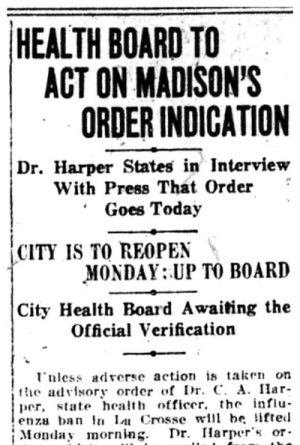
La Crosse Tribune 31 October 1918
While the epidemic had slowed by the end of October, State Health Officer Harper lifted the closed order and left it up to local control as to when to open up their communities again. Locally the Board lifted the ban on all public places and gatherings on Sunday, November 3 and schools were allowed to resume Monday, November 4.
Many communities saw a spike in the number of cases following the announcement that World War I had ended and that a truce had been signed. This occurred November 11 and was celebrated all over the United States. Apparently social distancing was not practiced as people danced in the streets and toasted to the armistice, as nationally an increase in Spanish flu cases was seen 10 days after the announcement. La Crosse County also finally authorized the hiring of a visiting nurse by November 22. This effort was spearheaded by a group of “656 mothers of La Crosse County.”
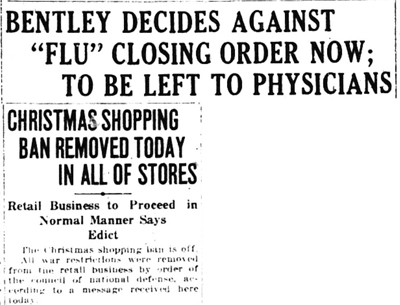
La Crosse Tribune 27 November 1918
By November 26, the local Board of Health realized that another wave of influenza had arrived and cautiously shut down schools and other public places where residents tended to gather. This time it was the mayor who decided against a closing order as he felt it should be left to the physicians to decide to close the schools. However, the National Council on Defense, lifted the restrictions against retail stores from war time limitations and that the “restoration was complete and final."
December 6 brought the order for the closing of dance halls and bans on public and private dances. Furstman stated there had been 13 deaths in the first week of December 1918 reported to the health office. St. Wenceslaus School saw 85% of pupils absent and one teacher was reported to be on her death bed. By December 8, it was said that 1,200 public school aged children were out of school or 28% enrolled. Abut 20 teachers were also absent.
By mid-December, the bottom had dropped out of the influenza epidemic in La Crosse and things were completely opened up and began to return to normal. The total number of deaths in the city for the October-December 1918 due to influenza and pneumonia was 93. The city health officer was pleased at this rate of mortality, especially for cities with a population of over 10,000, and claimed it had been the previous eight years of hard public health work that contributed to the low death rate. In the end, the State Board of Health reported La Crosse County with 176 deaths from Influenza in 1918. This put the county in the third category of 30-40 deaths per 10,000 which was the average range for most Wisconsin counties.
Click here for full Wisconsin Magazine of History article
The total number of cases in Wisconsin was estimated at 103,000 persons with 8,459 deaths or about 7,500 more than a normal year. The state had higher mortality numbers than Michigan, Indiana or Minnesota. More Wisconsinites died during the six months of the influenza epidemic than were killed in World War I, the Korean War and the Viet Nam War combined.
One last surge of influenza occurred in the first three months of 1920. La Crosse County reported 420 cases during January-February and 55 deaths for a death rate per cases as 7.6%. Those numbers are not included in the graphic above. Health Commissioner Furstman resigned his post in May 1919 and was replaced by Anthony M. Murphy, a well-respected public officer who retired in 1947 after serving the city for 40 years in the department.
All told, total La Crosse County deaths from the 1918 Pandemic came to 231 people, spanning from Oct. 1918-Feb. 1920.
Check out this WKBT tv interview with Anita regarding the 1918 pandemic in La Crosse to help put our community's experience into perspective with national and global events of the day.
Help contribute your voice to the La Crosse area COVID-19 experience survey. Become a primary source for future generations by documenting your reactionsand experiences of every day life has been under the shut down, and how the Safer at Home orders have affected you and your family long term.


